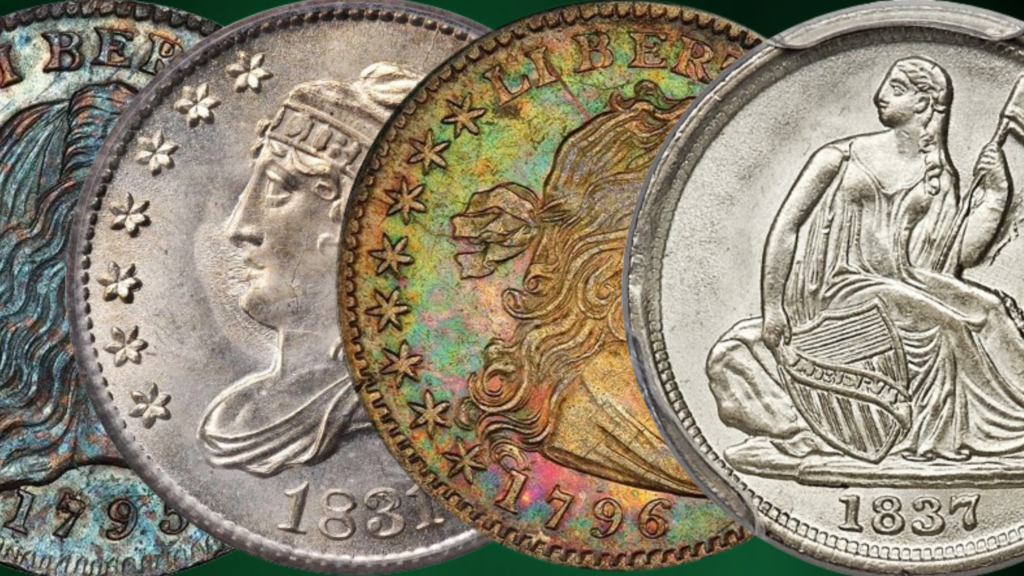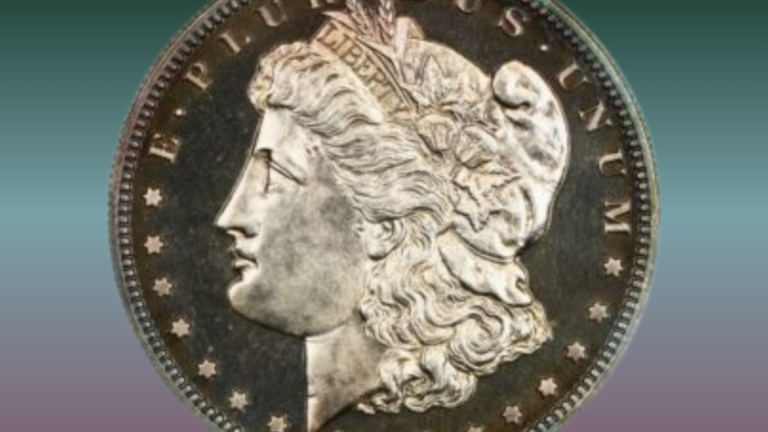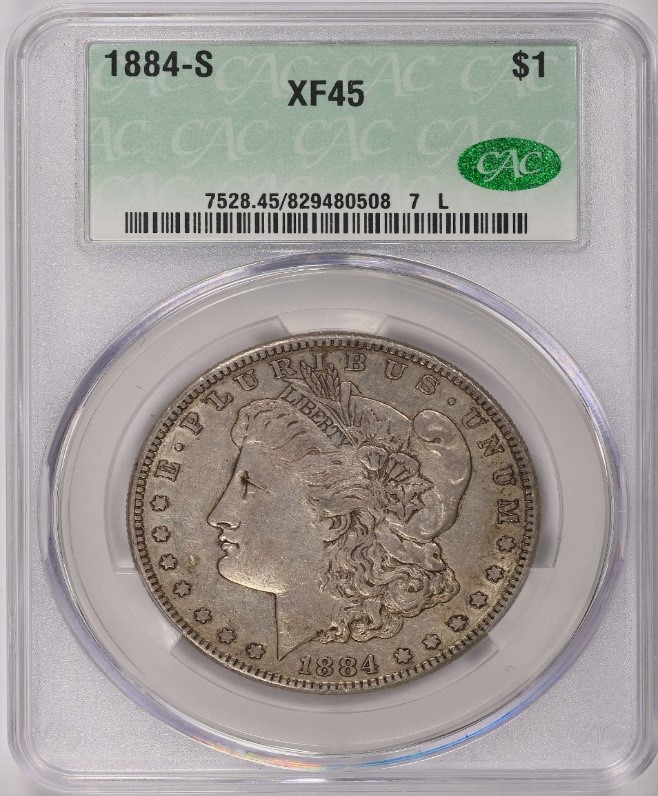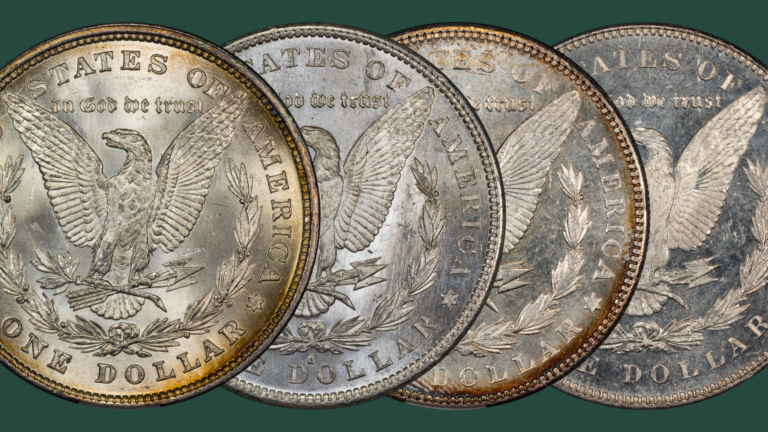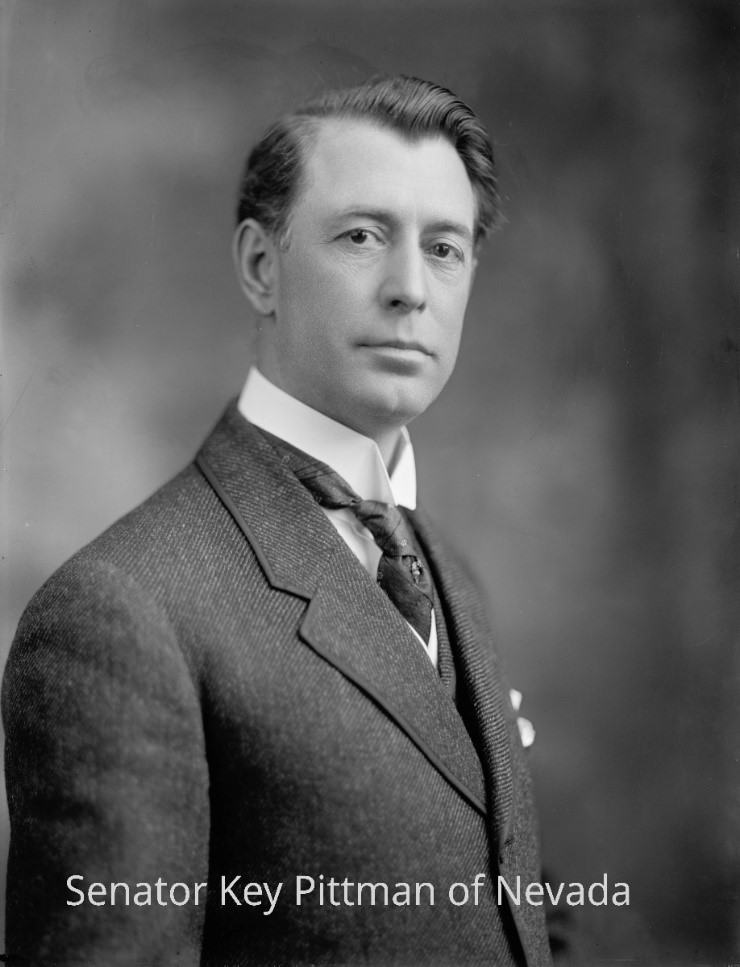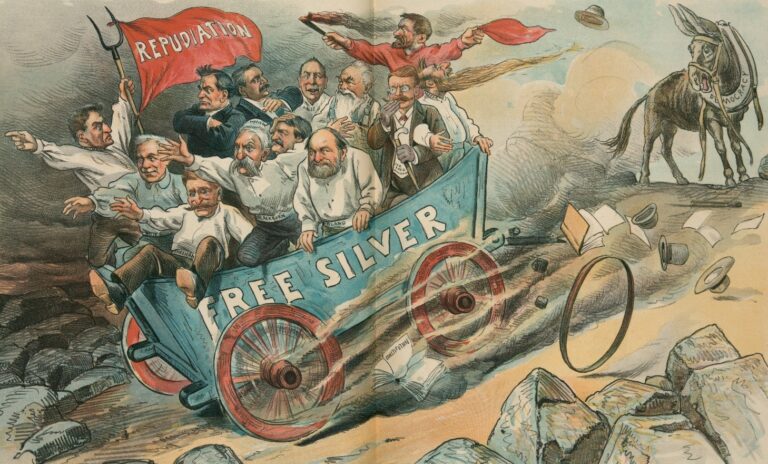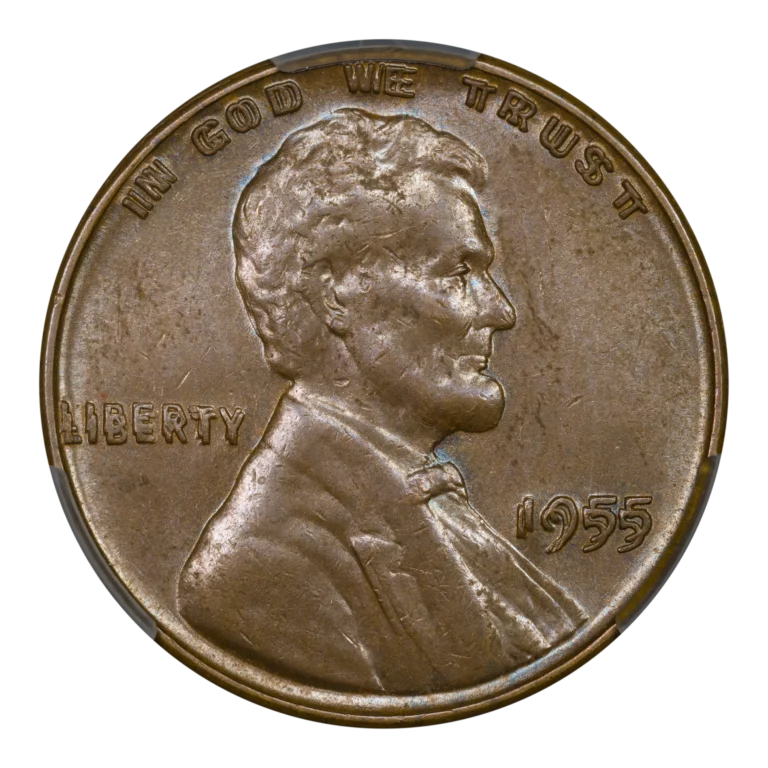by Greg Reynolds
Half dimes are silver coins that have a face value of five cents. Half dimes were minted from 1794 to 1873, though not during every year in between.
Half dimes were minted long before nickels were even imagined in the United States. Five cent nickels and Three Cent Nickels each consist of an alloy of 25% nickel and 75% copper. Half dimes never contained any nickel, and were specified to be half the weight of corresponding dimes from the same respective time period.
There are nine design types of half dimes. In discussions that explain that 1792 half dismes are patterns, not coins, it is emphasized that the U.S. coinage system and the U.S. monetary system overall were gradually adopted by U.S. citizens. In North America, the British Isles and Western Europe before the 1770s, no one was thinking in terms of a decimal system, except a few scientists and philosophers like Thomas Jefferson. Generally, decimal systems were not then used for a coinage system or for business accounting.
Design Type 1 – Flowing Hair
The U.S. silver dollar was directly based upon the “Spanish Milled Dollar,” which was the then current version of the Eight Reales coin of the Spanish Empire. Fractions of a dollar were thought of in eighths. Except Russia, which was not a leading force at the time, the leaders of the major powers of the world had yet to even consider a decimal system for coinage or accounting.
From long before the founding of the United States in 1776 until at least until the mid 1830s, the vast majority of silver coins in circulation in the U.S. were of the Spanish Empire and directly related societies. Spanish coins were denominated in multiples or fractions of eight. Although Quarter-Real (1/32 dollar) coins were around, there were many more Half-Real (1/16 dollar) coins in circulation than Quarter-Real coins. A Half-Real was worth 6.25 cents in U.S. terms, as it was one-sixteenth of a Spanish Milled Dollar (Eight Reales), which was the basis for the U.S. dollar. Even as late as the 1830s, a very large number of goods and services offered in the U.S. were priced at 6.25 cents or 12.5 cents.
There were no half dimes dated from 1806 to 1828 because there were large quantities of Half-Real coins and some Quarter-Real coins in circulation in the U.S. Half dimes were not demanded. They were struck in the 1790s mostly to introduce U.S. citizens to the new system, supporters of which knew would be puzzling and not immediately acceptable to many U.S. citizens. Early half dimes and dimes foreshadowed the future of the U.S. monetary sytem. Their popularity grew gradually.
In his landmark and widely accepted work, Fractional Money, economist Neil Carothers provided a large number of examples of goods in the U.S. that were priced in accordance with the Spanish system during the the first third of the 19th century. He also mentioned a few examples of such prices being charged in the 1840s and 1850s. He was referring to goods priced at 6.25, 12.5. 18.75 or 37.5 cents. Half dimes were often annoying. Before the 1830s, it was easier to use coins of the Spanish Empire and related societies, which were readily available.
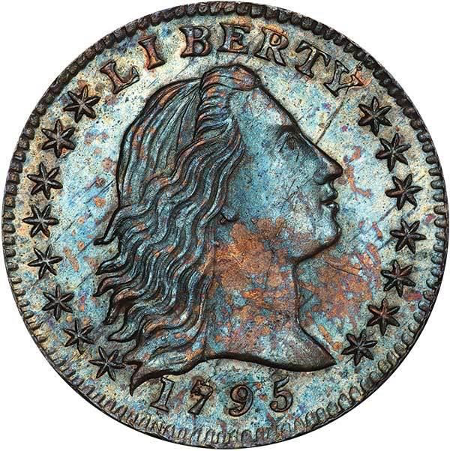
Of course, more and more merchants over time adopted the new U.S. system, and there was significant demand for U.S. half dimes by the 1830s, and always a little demand before then. Curiously, all 1794 half dimes were struck in 1795, though 1794 half dollars and silver dollars were struck in 1794. The Flowing Hair design was also employed for half dollars and silver dollars.
Design Type 2 & 3 – Draped Bust Small and Heraldic Eagle
Draped Bust obverse (front), Small Eagle reverse (tail) half dimes, dimes and half dollars were minted in 1796 and 1797. Quarter dollars of the same design constitute a one-year type, 1796 only. Because of the vast number of Two Reales coins in circulation, there were minimal requests for U.S. quarters before the 1820s.
This ‘Small Eagle’ concept is not really small. It is said to be ‘small’ because it is significantly smaller than the Heraldic or “Large Eagle” design element, which occupies most of the reverse die. Indeed, the Heraldic Eagle design concept dominates the reverse of coins where it is featured.
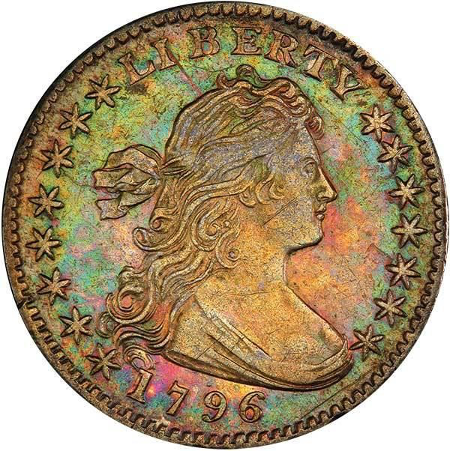
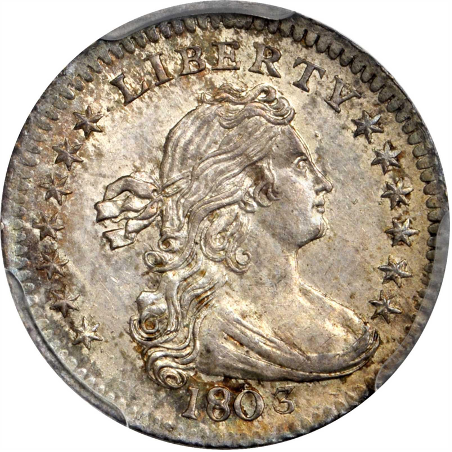
The ‘Small Eagle’ is often thought to be symbolic of the fact that the U.S. was then a young and growing nation, destined to become larger and stronger. The ‘Heraldic Eagle’ motif is based upon the design of The Great Seal of the United States, which was formally adopted by the U.S. Congress in 1782.

Design Type 4 – Capped Bust
Although production of half dimes temporarily ceased in 1805, Capped Bust half dollars were introduced in 1807 and Capped Bust dimes were first minted in 1809. The first Capped Bust quarters are dated 1815, yet Capped Bust half dimes were not introduced until 1829. The Capped Bust design is credited to John Reich. The application of the overall Capped Bust design to half dime coinage was probably effected by William Kneass.
From 1794 to 1836, half dimes along with other U.S. silver coins were specified to be of an alloy that is 89.243% silver (1485/1664) and 10.757% copper. The U.S. Mint Act of 1837, which was passed on January 18, 1837, changed the composition to 90% silver (“900 fine”) and 10% copper. As for whether Capped Bust 1837 half dimes are 89.243% silver or 90% silver, I do not know.
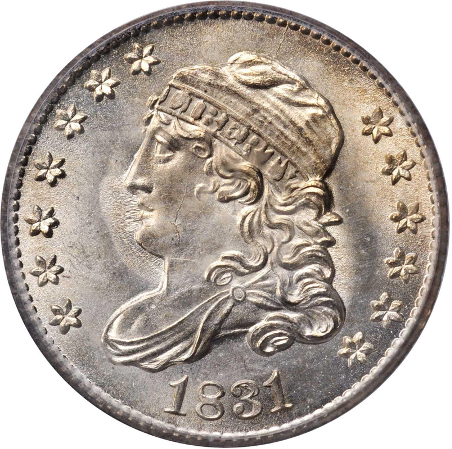
The testing of a few Capped Bust 1837 half dimes would not provide enough data to draw a firm conclusion, especially since the pre-1837 weight falls into the allowable standard deviation for the weight standard that was implemented early in 1837. Fortunately, technology employed for testing the metallic composition of objects has advanced considerably over the last three decades. It has become increasingly less difficult to reliably distinguish 89.243% silver content from 90% silver. Have many 1837 Capped Bust half dimes been subject to rigorous elemental testing with relatively current technology?
Design Type 5 – Liberty Seated, No Stars
As Liberty Seated half dimes were introduced during 1837, it is likely that these were minted in accordance with the new standard and thus were intended to be 90% silver. There are Liberty Seated dimes, quarters, half dollars and silver dollars as well. Most U.S. silver coins dating from 1837 to 1891 feature a Liberty Seated motif, which was credited to Christian Gobrecht, though he was inspired by recognized, pre-existing artwork, including the concept of Britannia on many coins of the U.K.
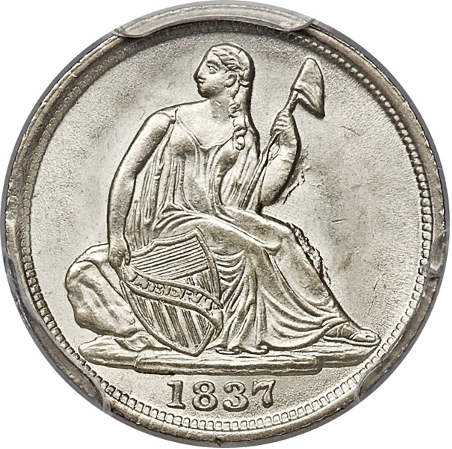
Dies for Gobrecht silver dollars and patterns dating from 1836 were engraved by Christian Gobrecht. Some 1836, 1838 and 1839 Gobrecht silver dollars have the legal status of coins, though they were thought of as patterns until path breaking research by R. W. Julian in the middle of the 20th century shed much light on their history. Gobrecht dollars, though, are different artistically and stylistically from the Liberty Seated types that were dominant for decades.
Liberty Seated dimes, quarters and half dollars lasted until 1891. Liberty Seated silver dollars, along with half dimes, were terminated in 1873.

Show off Your Collection in the CAC Registry!
Have CAC coins of your own? If so, check out the CAC Registry–the free online platform to track your coin inventory, showcase your coins by building public sets, and compete with like-minded collectors!
Design Type 6 – Liberty Seated, No drapery
Half dimes were the first of the Liberty Seated types. Quarters followed in 1838, half dollars in 1839 and silver dollars in 1840. Before 1838, all U.S. coins were minted in Philadelphia. The first U.S. Branch Mint to produce U.S. silver coins was established in New Orleans in 1838, and 1838-O half dimes were minted there.
Half dimes generally weigh half as much as corresponding dimes and contain half the silver content. The diameter of each half dime, however, is more than half the diameter of a corresponding dime. Half dimes are thinner, in terms of ‘physical depth.’ Indeed, half dimes were often accidentally bent.
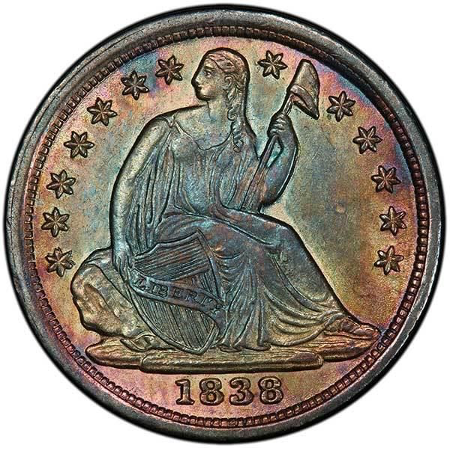
The Mint Act of 1792 required that each half dime (then spelled “disme”) contain eighteen and nine-sixteenths grains of pure silver (18.5625 grains = 0.0386 Troy ounce), about 1.2 grams. Each half dime was specified to weigh twenty and four-fifths grains (20.8 grains = .043333 Troy ounce) in total, as silver and gold coins were specified to be 1485/1664 (89.243%) pure.
Reference guides that convert such weight requirements into grams, without an explanation, are misleading as grains were then the standard of measurement, though silver and gold were often indicated in Troy ounces (480 grains = 1 Troy ounce). The uses of three, five and twelve as multipliers stem from British customs, which are related to Ancient Rome. The use of eighths and multiples of eight in calculations was a Spanish tradition. Until monetary perspectives began to change in Western Europe and The Americas during the 1790s, the concept of a decimal system was considered annoying and strange by the few members of the general public who thought about tenths or multiples of ten at all.
Half dimes minted from 1794 to 1805 were specified to be two-thirds of one inch in diameter. In 1829, the standard for the diameter of a half dime was reduced to five-eighths of an inch, though the weight standard was unchanged. Capped bust half dimes are thus not as thin as Flowing Hair and Draped Bust half dimes.
Although the net silver content of a half dime (18.5625 grains) remained the same, the Mint Act of 1837 increased the ‘fineness’ from 1485/1664 (= 89.24%) to 900/1000 (=90%). The total weight was thus reduced to twenty and five-eighths (20.625 grains = .043 Troy ounce), with an allowable deviation of 0.5 grains. The change in silver percentage was largely symbolic as it indicated that the Spanish way of thinking about monetary denominations had faded and a decimal system had become largely accepted in the U.S.
The Mint Act of 1853 reduced the authorized weight of each half dime to 19.2 grains. The reduction in weight was announced by the addition of arrows to the obverse designs of half dimes, dimes, quarters, and half dollars. The authorized weight of a silver dollar was not reduced by this law.
Although a seated, female personification of liberty, with a shield, and with a pole topped by a liberty cap, is always the central feature of Liberty Seated half dimes, aspects of the design were modified by engravers over the years. The outer design elements of Liberty Seated half dimes were markedly changed in 1838 and especially in 1860.
Design Type 7, 8, 9 – Liberty Seated Arrows, Stars, Legend
The obverse fields of the initial type of Liberty Seated half dimes (1837-38) are plain. In 1838, stars were added to the designs of half dimes and dimes.
The “With Drapery” design was introduced in 1840. This term, “With Drapery,” refers to the addition of fabric in the design of Miss Liberty’s gown. This change is very much evident about her elbow and forearm, near the pole. While the change in the design of her gown is noticeable, the differences between ‘No Drapery’ and ‘With Drapery’ coins involve far more than the addition of this ‘drapery.’
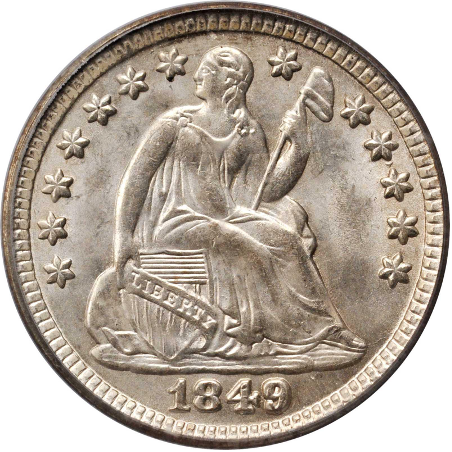
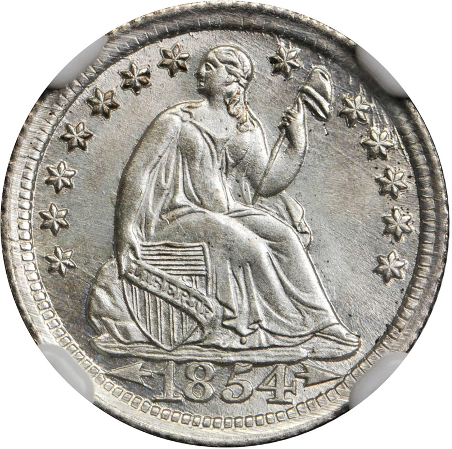
Robert Ball Hughes did not just add material to her gown; Hughes changed the artistic concept of Miss Liberty. Her clothes overall are of a different style. Miss Liberty’s head and arms were enlarged. The shape of Miss Liberty’s body was modified, really a different female personification of Liberty.
A very noticeable difference relates to the shield. On the ‘No Drapery’ coins, the shield tilts to the observer’s left. The shield is upright or nearly so on ‘With Drapery’ half dimes.
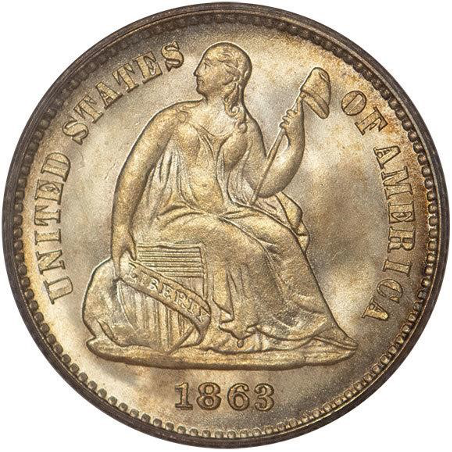
It could be argued that 1859 half dimes constitute a one-year type. While Anthony Paquet copied the general forms and layout of the Gobrecht-Hughes design, Paquet was responsible for a modified obverse design that subtly showcased Paquet’s trademark styles, sort of like distinctive penmanship. While numerals and stars are very apparently of Paquet’s style, finer aspects of Miss Liberty’s head, hair and body are all different, too. The overall design concepts, though, are the same.
James Longacre was responsible for substantial changes that were effected in 1860. The legend, “UNITED STATES OF AMERICA,” was moved from the reverse (back) to the obverse. The letters in ‘half dime’ were reduced in size. A plain wreath was replaced by a larger wreath that featured multiple agricultural products including corn and wheat. The half dimes of 1860 to 1873 are of a clearly different design type.
The Coinage Act and Impacting Factors
The Coinage Act of 1873 brought about major changes in coinage policy. One provision abolished half dimes altogether.
The advent of Three Cent Nickels in 1865 and of five cent nickels in 1866 diminished the role of half dimes. Moreover, it was less costly for the U.S. Mint to manufacture five cent nickels, as these did not contain any silver. Nickels were also indicative of a shift in political and economic views.
Before the U.S. Civil War, a non-silver five cent coin would not have been widely accepted, and would have been viewed with suspicion. By the middle of the 1860s, U.S. citizens were far more accepting of coins that had intrinsic values that were much lower than their respective face values. The intrinsic value refers to the then current market value of the metals in a coin. A coin’s intrinsic value exists independently of its face value, which is usually determined by law or decree.
While people in the 1860s and 1870s still cared about the intrinsic values of dimes, quarters and half dollars, the Coinage Act of 1853 was a watershed in that all silver coins valued under one dollar were specified to have an intrinsic value that was less than their respective face value. A half dime contained less than five cents worth of silver, and a dime contained less than ten cents worth of silver. People thus had a stronger motive to spend, rather than hoard, half dimes, dimes, quarters and half dollars.
The discovery of large quantities of gold in California, beginning in 1849, had upset the balance between the values of silver and gold. A major increase in the supply of gold caused the market value of gold to fall below its legally specified U.S. dollar value and the value of silver increased such that people had a financial motive to hoard rather than spend silver coins.
The specified weight of a silver dollar was not affected by the Coinage Act of 1853, and thus an official policy of bimetallism at the old exchange rates was technically still in force. Most U.S. citizens realized, however, that silver had increased in value while gold had decreased. Eventually, much more silver was mined.
Multiple factors contributed to U.S. citizens becoming accustomed to accepting and spending coins that had metal or ‘melt’ values that were below their respective face values. Three Cent Silvers in 1851, the already mentioned silver denominations in 1853, Three Cent Nickels in 1865 and five cent nickels in 1866 all were part of a major change in monetary policy and attitudes. By the late 1860s, there were millions of Three Cent Silvers, Three Cent Nickels and five cent nickels, all of which had intrinsic or metal values that was markedly lower than their respective face values. Societal attitudes about coins and money had changed.
Half dimes became obsolete because an overwhelming majority of U.S. citizens were willing to accept and frequently spend five cent coins that had no silver content. Before 1850, a five cent coin without silver would have been unthinkable.
Images are courtesy of Legend Auctions and Stack’s Bowers.
Copyright © 2020 Greg Reynolds
About the Author
Greg is a professional numismatist and researcher, having written more than 775 articles published in ten different publications relating to coins, patterns, and medals. He has won awards for analyses, interpretation of rarity, historical research, and critiques. In 2002 and again in 2023, Reynolds was the sole winner of the Numismatic Literary Guild (NLG) award for “Best All-Around Portfolio”.
Greg has carefully examined thousands of truly rare and conditionally rare classic U.S. coins, including a majority of the most famous rarities. He is also an expert in British coins. He is available for private consultations.
Email: Insightful10@gmail.com
